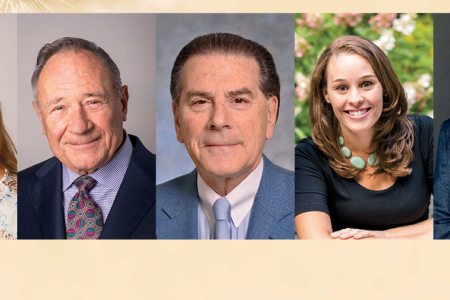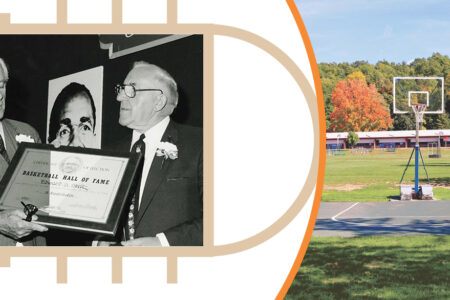Basketball Was Born Here
Basketball’s very inauspicious beginnings highlight two of the most significant components of a Springfield College education: hands-on experiential learning opportunities (which we call the “early and often” approach), and faculty members who are willing to partner and work with our students from their first steps on the campus.
Basketball’s very inauspicious beginnings highlight two of the most significant components of a Springfield College education: hands-on experiential learning opportunities (which we call the “early and often” approach), and faculty members who are willing to partner and work with our students from their first steps on the campus.
Basketball was born here. It is a slogan that pervades our heads, our hearts, and copious marketing materials at Springfield College. But, what does it mean to our institution—to the world—that basketball was born at Springfield College 125 years ago?
Basket ball, as it was originally known, is an innovation that seems unique to the general public, but to those of us who know Springfield College, it is consistent with the many innovations that showcase the everyday application of our mission to educate students in spirit, mind, and body for leadership in service to others. And, it showcases the relevance of a Springfield College education today.
When the game’s inventor, alumnus James Naismith from the Class of 1891, discovered through his own involvement in college sport that men could be positively influenced through the “athletic side of their nature,” he saw opportunities in that line of work and came to Springfield College (known then as the International YMCA Training School) because he sought the highest quality academic programming. At the time Naismith applied, Luther Halsey Gulick, the father of physical education and superintendent of the College’s physical department, was the lead practitioner in this field.
Basketball’s very inauspicious beginnings highlight two of the most significant components of a Springfield College education: hands-on experiential learning opportunities (which we call the “early and often” approach), and faculty members who are willing to partner and work with our students from their first steps on the campus. Both components were present in the case of the game’s inventor, James Naismith, just as they continue to be today.
In 1891, Naismith was an instructor charged with the task of creating a new indoor game for a class of “ruffian” disinterested students that would be interesting, easy to learn, and easy to play indoors and with however many individuals were present, providing him with practical experience, the first component. Naismith rose to the challenge and, if you’re reading this, you likely know the rest. The second component was the person who charged Naismith with the task in the first place, faculty member Luther Halsey Gulick, who had formed an important instructional bond with Naismith while Naismith was a graduate student, providing unique educational opportunity.
Because the College was the preeminent educator of YMCA leaders at the time (a role it continues to fill), basketball was particularly well positioned to spread quickly. As students graduated and took up Y posts around the world, they brought basketball with them. This explains how the game had such tremendous international success in a relatively short period of time. By the turn of the century, basketball was being played on five continents, and made its Olympic debut in Berlin in 1936. Springfield College alumni coached a significant number of those first Olympic teams.
Today, it is a game that is particularly relevant in the world. It is a game that unites races and classes. It’s a game that unites cultures. It is a game that very successfully crosses gender. It’s a game that doesn’t require expensive equipment or new age turf fields, or elaborate uniforms and padding. It’s a game that levels the playing field among people and shares the age-old Springfield College ambition of wellness and fitness for everyone.
Springfield College has continued as a world leader in basketball, and faculty, alumni, and athletics directors throughout our history have been influential in helping to promote the game worldwide and in establishing rules and policy that continue to govern the sport today. Those influential individuals include hall of famers Naismith, Gulick, Edward Hickox, Amos Alonzo Stagg, Arthur Schabinger, John Bunn, R. William Jones, Ferenc Hepp, and Edward Steitz, as well as former head athletic director and head coach Edward Bilik and our current head coaches, who remain active in the sport leadership. Our men’s coach, Charlie Brock, is an active member of the National Association of Basketball Coaches Board of Directors, and our women’s coach, Naomi Graves, has been a clinician in Hong Kong the past two summers. The first Naismith Memorial Basketball Hall of Fame opened on our campus in 1968 and resided here until it moved downtown in 1985.
Although this could be a story about Naismith the innovator, Naismith the inventor, it’s really a story about an institution—and the leaders of its physical education and wellness program—with values and a mission to care for the whole person, no matter who that person was. Back then the game was disinterested in whether that person was a trained athlete or a “ruffian” student. Today it is disinterested in whether its player is male or female, an ACC player, a suburban parent, or a city kid at the playground. It is the great equalizer.
And, it was born here.
Editor’s Note: Hear Naismith talking about the game at springfield.edu/naismithaudio. Learn more at springfield.edu/birthplace. Many thanks to Springfield College Archivist Jeffrey Monseau for his contributions to this article.




